初中英语语法全解——时态(共19张PPT)
文档属性
| 名称 | 初中英语语法全解——时态(共19张PPT) |  | |
| 格式 | ppt | ||
| 文件大小 | 1.9MB | ||
| 资源类型 | 教案 | ||
| 版本资源 | 通用版 | ||
| 科目 | 英语 | ||
| 更新时间 | 2022-04-10 10:52:23 | ||
图片预览

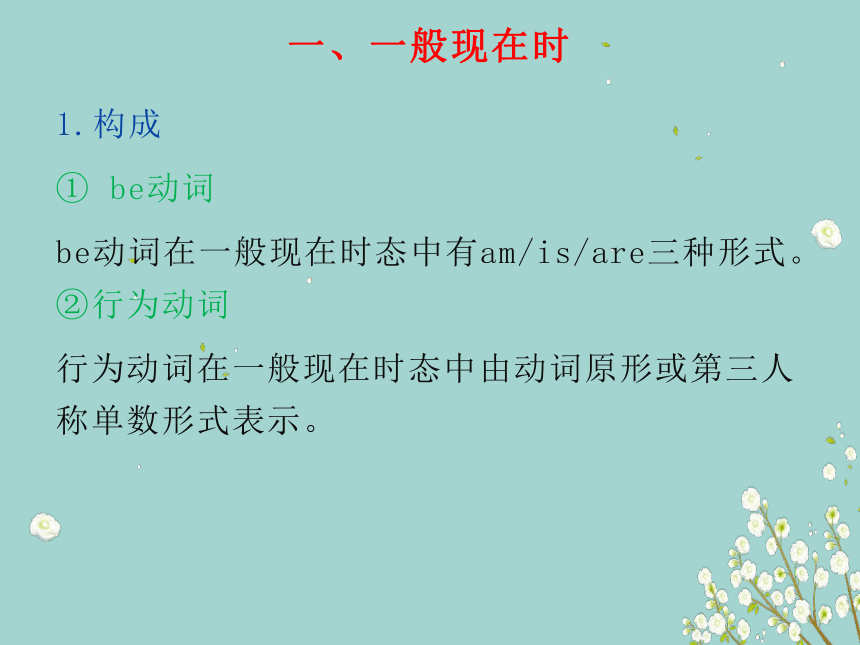
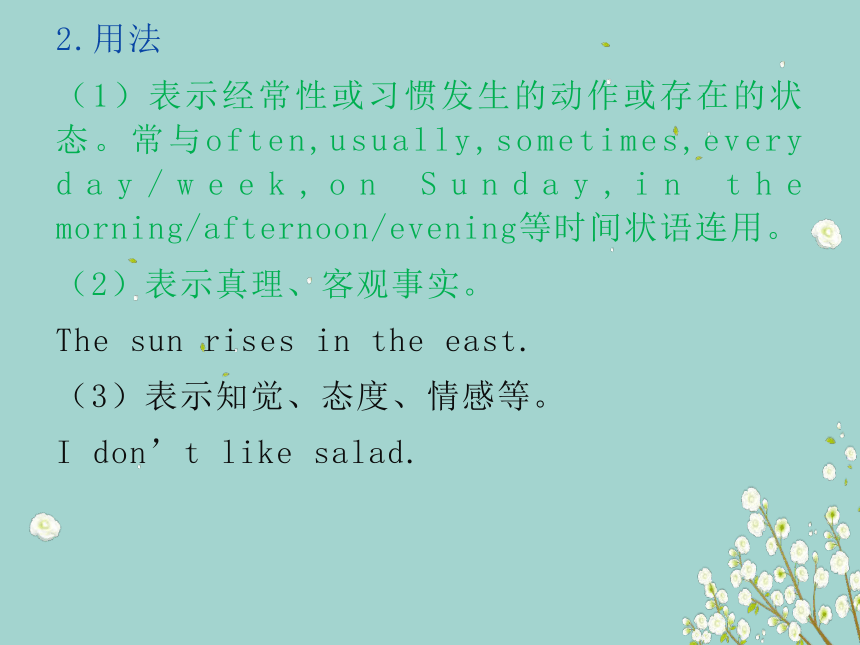
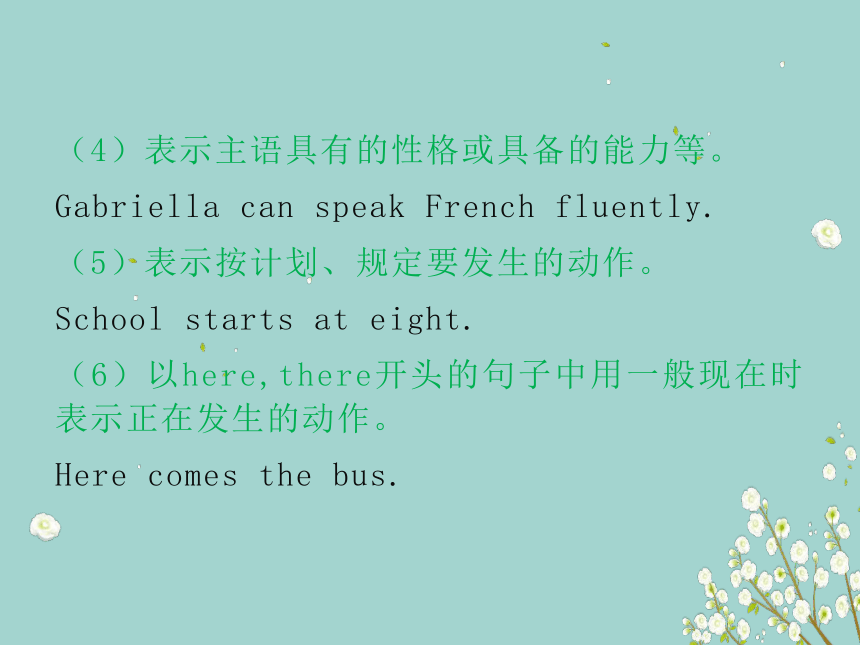
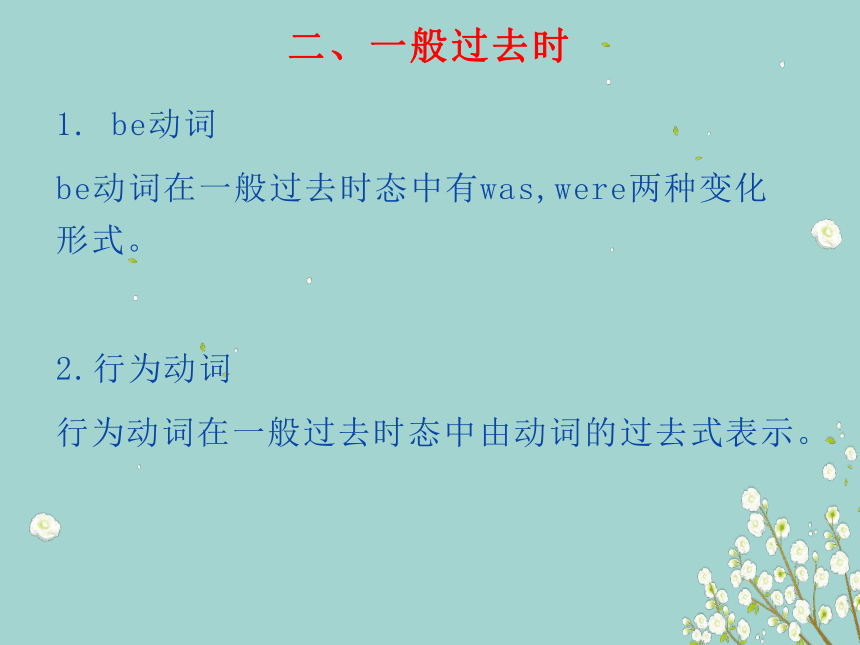

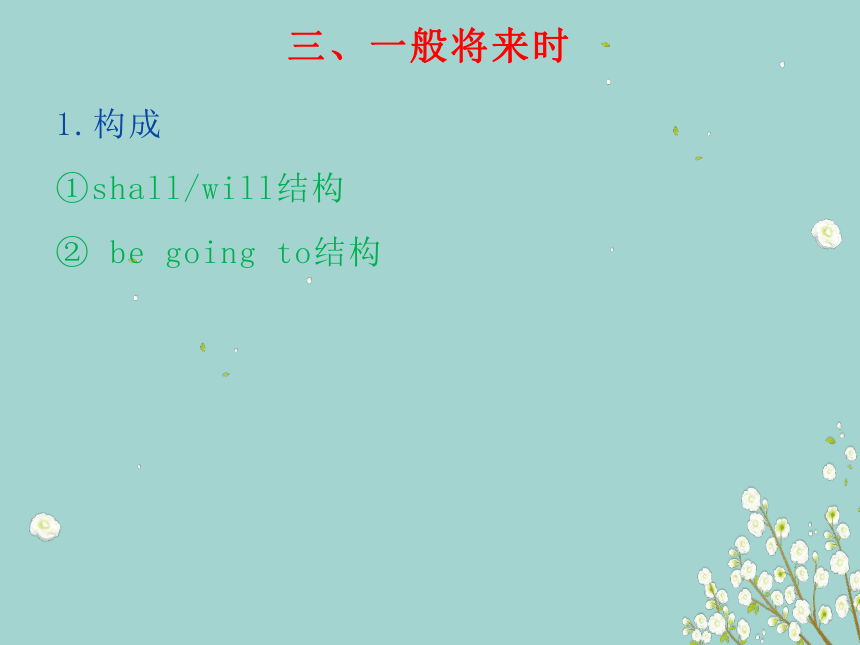
文档简介
(共19张PPT)
初中英语语法全解—时态
一、一般现在时
1.构成
① be动词
be动词在一般现在时态中有am/is/are三种形式。②行为动词
行为动词在一般现在时态中由动词原形或第三人称单数形式表示。
2.用法
(1)表示经常性或习惯发生的动作或存在的状态。常与often,usually,sometimes,every day/week,on Sunday,in the morning/afternoon/evening等时间状语连用。
(2)表示真理、客观事实。
The sun rises in the east.
(3)表示知觉、态度、情感等。
I don’t like salad.
(4)表示主语具有的性格或具备的能力等。
Gabriella can speak French fluently.
(5)表示按计划、规定要发生的动作。
School starts at eight.
(6)以here,there开头的句子中用一般现在时表示正在发生的动作。
Here comes the bus.
二、一般过去时
1. be动词
be动词在一般过去时态中有was,were两种变化形式。
2.行为动词
行为动词在一般过去时态中由动词的过去式表示。
3.用法
(1)表示在过去某一具体时间发生的动作或存在的状态。常与yesterday,last week,a moment ago,two hours ago,just now,at that time,in 1990等时间状语连用。
Last week we asked our students about their free time activities.
(2)表示过去经常性或习惯性的动作。
He always helped me with my English in the past.
三、一般将来时
1.构成
①shall/will结构
② be going to结构
2.用法
(1)表示将来某个时间要发生的动作或存在的状态。常与tomorrow,next week,in a month,in the future等时间状语连用。
Will people use money in 100 years
(2)“be going to+动词原形”主要表示打算、计划、决定要做的事或有迹象表明要发生某事。
I’m going to write articles and send them to magazines and newspapers.
(3)“be to+动词原形”表示安排、计划在近期将要发生的事。
She is to arrive in Beijing today.
(4)“be about to+动词原形”表示事情或动作马上要发生,一般不用时间状语。
Don’t go out now. We are about to have lunch.
四、现在进行时
1.构成:am/is/are doing
2.用法
①现在进行时表示现在正在进行或发生的动作。常与now,at the moment等状语连用。
There are many people here on vacation.Some are taking photos.Others are lying on the beach.
②表示当前一段时间内的活动或现阶段正在进行的动作。常与at present,these days,this week等时间状语连用。
Mr. White is writing a book at present.
③现在进行时与always连用时,表示赞扬或厌恶的意思。
They are always helping us.
五、过去进行时
1.构成:was/were doing
2.用法
①表示过去某一时刻正在进行的动作或发生的事情。常与at that moment/time,yesterday等时间状语或when,while等引导的时间状语从句连用。
When you called, I was taking a shower.
②表示过去某一段时间正在进行的动作。
What were you doing from eight to ten last night
六、现在完成时
1.构成:have/has done
2.用法
①表示过去发生或已经完成的动作对现在造成的影响或结果。常与副词already,ever,never,just,yet等连用。
Our guests have arrived.
②表示过去已经开始,持续到现在的动作或状态,也许还要继续下去。常与for或since引导的时间状语连用。这时谓语动词必须使用延续性动词,如be,live,teach,learn,work,study,know等。
I haven’t been back for almost three years.
③have/has been to表示“曾经到过某地”;而have/has gone to表示“已经去某地了”。
They have been to India twice.
George has gone to London.
七、过去完成时
1.构成:had done
2.用法
①过去完成时表示在过去某一时刻或动作之前已经发生或完成了的动作,即“过去的过去”。这个过去的时刻常用由by,before等引导的介词短语或时间状语从句表示,也可以表示过去的动作来表示。
The phone was ringing but by the time she got indoors, it had stopped.
②过去完成时也表示从过去某一时间开始,持续到过去灵异事件的动作或状态。常和由for,since引导的表示一段时间的短语或从句连用。
He had studied in the school for about two years before he moved here.
八、过去将来时
1.构成:would do
2.用法
过去将来时表示从过去的某一时间看将要发生的动作或存在的状态,常用于宾语从句或间接引语中。
Arnold knew he would be tired the next day.
初中英语语法全解—时态
一、一般现在时
1.构成
① be动词
be动词在一般现在时态中有am/is/are三种形式。②行为动词
行为动词在一般现在时态中由动词原形或第三人称单数形式表示。
2.用法
(1)表示经常性或习惯发生的动作或存在的状态。常与often,usually,sometimes,every day/week,on Sunday,in the morning/afternoon/evening等时间状语连用。
(2)表示真理、客观事实。
The sun rises in the east.
(3)表示知觉、态度、情感等。
I don’t like salad.
(4)表示主语具有的性格或具备的能力等。
Gabriella can speak French fluently.
(5)表示按计划、规定要发生的动作。
School starts at eight.
(6)以here,there开头的句子中用一般现在时表示正在发生的动作。
Here comes the bus.
二、一般过去时
1. be动词
be动词在一般过去时态中有was,were两种变化形式。
2.行为动词
行为动词在一般过去时态中由动词的过去式表示。
3.用法
(1)表示在过去某一具体时间发生的动作或存在的状态。常与yesterday,last week,a moment ago,two hours ago,just now,at that time,in 1990等时间状语连用。
Last week we asked our students about their free time activities.
(2)表示过去经常性或习惯性的动作。
He always helped me with my English in the past.
三、一般将来时
1.构成
①shall/will结构
② be going to结构
2.用法
(1)表示将来某个时间要发生的动作或存在的状态。常与tomorrow,next week,in a month,in the future等时间状语连用。
Will people use money in 100 years
(2)“be going to+动词原形”主要表示打算、计划、决定要做的事或有迹象表明要发生某事。
I’m going to write articles and send them to magazines and newspapers.
(3)“be to+动词原形”表示安排、计划在近期将要发生的事。
She is to arrive in Beijing today.
(4)“be about to+动词原形”表示事情或动作马上要发生,一般不用时间状语。
Don’t go out now. We are about to have lunch.
四、现在进行时
1.构成:am/is/are doing
2.用法
①现在进行时表示现在正在进行或发生的动作。常与now,at the moment等状语连用。
There are many people here on vacation.Some are taking photos.Others are lying on the beach.
②表示当前一段时间内的活动或现阶段正在进行的动作。常与at present,these days,this week等时间状语连用。
Mr. White is writing a book at present.
③现在进行时与always连用时,表示赞扬或厌恶的意思。
They are always helping us.
五、过去进行时
1.构成:was/were doing
2.用法
①表示过去某一时刻正在进行的动作或发生的事情。常与at that moment/time,yesterday等时间状语或when,while等引导的时间状语从句连用。
When you called, I was taking a shower.
②表示过去某一段时间正在进行的动作。
What were you doing from eight to ten last night
六、现在完成时
1.构成:have/has done
2.用法
①表示过去发生或已经完成的动作对现在造成的影响或结果。常与副词already,ever,never,just,yet等连用。
Our guests have arrived.
②表示过去已经开始,持续到现在的动作或状态,也许还要继续下去。常与for或since引导的时间状语连用。这时谓语动词必须使用延续性动词,如be,live,teach,learn,work,study,know等。
I haven’t been back for almost three years.
③have/has been to表示“曾经到过某地”;而have/has gone to表示“已经去某地了”。
They have been to India twice.
George has gone to London.
七、过去完成时
1.构成:had done
2.用法
①过去完成时表示在过去某一时刻或动作之前已经发生或完成了的动作,即“过去的过去”。这个过去的时刻常用由by,before等引导的介词短语或时间状语从句表示,也可以表示过去的动作来表示。
The phone was ringing but by the time she got indoors, it had stopped.
②过去完成时也表示从过去某一时间开始,持续到过去灵异事件的动作或状态。常和由for,since引导的表示一段时间的短语或从句连用。
He had studied in the school for about two years before he moved here.
八、过去将来时
1.构成:would do
2.用法
过去将来时表示从过去的某一时间看将要发生的动作或存在的状态,常用于宾语从句或间接引语中。
Arnold knew he would be tired the next day.
同课章节目录
- 词法
- 名词
- 动词和动词短语
- 动词语态
- 动词时态
- 助动词和情态动词
- 非谓语动词
- 冠词
- 代词
- 数词和量词
- 形容词副词及其比较等级
- 介词和介词短语
- 连词和感叹词
- 构词法
- 相似、相近词比较
- 句法
- 陈述句
- 一般疑问句和否定疑问句
- 特殊疑问句及选择疑问句
- 反意疑问句
- 存在句(There be句型)
- 宾语从句
- 定语从句
- 状语从句
- 主谓一致问题
- 简单句
- 并列句
- 复合句
- 主谓一致
- 主、表语从句
- 名词性从句
- 直接引语和间接引语
- 虚拟语气
- 感叹句
- 强调句
- 倒装句
- 祈使句
- 句子的成分
- 句子的分类
- 题型专区
- 单项选择部分
- 易错题
- 完形填空
- 阅读理解
- 词汇练习
- 听说训练
- 句型转换
- 补全对话
- 短文改错
- 翻译
- 书面表达
- 任务型阅读
- 语法填空
- 其他资料
